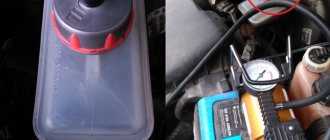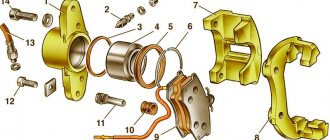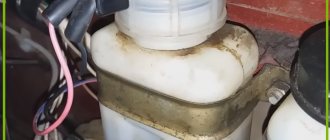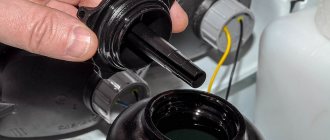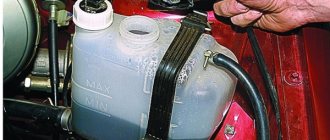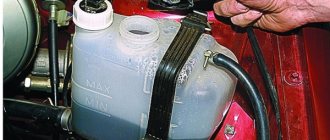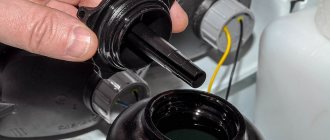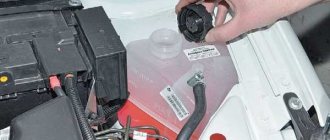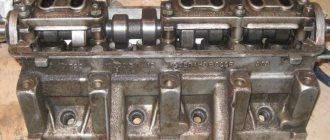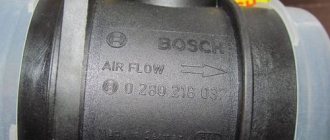According to statistics from the European Motorists' Community (ECA) for 2015 - 2021, 23% of accidents are caused by a faulty brake system.
Owners often underestimate the importance of brake circuit prevention (hereinafter referred to as TC). Late replacement of friction linings, late fluid renewal and monitoring of fluid levels are the most common factors.
The process of independently servicing the fuel tank and replacing the fluid is not at all difficult, but it requires attentiveness on the part of the technician. Violation of the regulations is unacceptable.
What brake fluid should be used in a VAZ 2114 car
According to the manufacturer's recommendations, set out in the VAZ 2114 operating instructions, the “update” of the TZ is carried out every three years or 45 – 50 thousand km, whichever comes first.
Since 1995, DOT-4 has been added to the brake circuit. Previous classes were canceled due to ineffectiveness and non-compliance with standards.
In the European Union, DOT-5 and even DOT-6 are used for transport vehicles, but for domestic transport the fourth generation is sufficient.
TJ has one significant drawback - absorption of moisture and condensation. The molecular structure is hygroscopic. The more water absorbed, the fewer nutrients inside and the weaker the structure.
Fresh DOT-4 has a boiling point of 245 degrees Celsius; after a run of 50–60 thousand km, the boiling point is reduced to 145–150°. Which can lead to an emergency if untimely prevention is not performed.
Service station technicians do not recommend mixing different types and classes of fuel fluid, despite the fact that many manufacturers do not prohibit this. There is a marketing component here.
Selecting brake fluid and the procedure for replacing it on a VAZ 2114
For the normal functioning of the vehicle’s vehicle with maximum efficiency, it is important for the car owner to correctly select the working fluid for the hydraulic brake drive. Modern TG, such as “Rosa” and its varieties, are based on polyglycols and this accounts for from 93 to 98 percent of the total composition. The rest is various additives that are necessary to combat oxidation of fuel fluid and prevent corrosion of metal parts of the vehicle.
When purchasing a vehicle, you need to pay attention to the following parameters:
- boiling point, it should be high to reduce the likelihood of plug formation from steam bubbles;
- good viscosity, which characterizes the ability to pump liquid in the system;
- the ability to absorb water, that is, hygroscopicity;
- ability to lubricate internal surfaces;
- neutrality in relation to rubber parts of the braking system;
- oxidation resistance and corrosion resistance.
According to the TZh class for the VAZ 2114, they are marked DOT 3.
How to change the brake fluid on a VAZ 2114 - for the correct actions you need to carefully study the car’s operating manual.
Before starting work, you need to prepare the necessary tools and materials:
- TJ in the amount of 0.5 liters;
- keys and screwdrivers;
- transparent flexible hose;
- container for draining spent fuel oil;
- rags to wipe surfaces, especially plastic and painted ones, since the liquid is toxic and aggressive to these surfaces.
To replace the turbocharger, you need to hire an assistant, because it requires bleeding the system using the brake pedal.
Welcome, friends, to the DIY car repair website. After long-term operation, all fluids used on the car must be changed and brake fluid is no exception.
The timing of replacement depends on the functions of the fluid itself. You can find out this period in the operating manual for a specific car brand.
Brake fluid is replaced on average once every 3 years, which corresponds to a mileage of approximately 45-50 thousand kilometers. A little later, the antifreeze is replaced, which also needs to be remembered.
Brake fluid tends to absorb moisture, that is, scientifically speaking, it is hygroscopic. The proportion of moisture in it is of course minimal, but still, over time, the substances that are included in it lose their properties.
Let's look at an example, let's say fresh TJ (DOT-4) has a boiling point of 240 degrees Celsius, and the old one, which contains some moisture, already has a boiling point of about 155 degrees, which is significantly lower than new or fresh liquid.
These are, of course, approximate values; much depends on the type of liquid, but still, the boiling point of old liquids is significantly reduced, which can lead to failure of the brake system and safe driving of the vehicle.
Mixing brake fluids is also not recommended. The manufacturers that make them use completely different standards and features.
Nowadays, most modern cars use brake fluids of the DOT-4 type; it is perfect for both drum and disc brakes.
What is the function of brake fluid
The brake fluid transfers kinetic energy from the cylinder to the pads when the brake pedal is pressed. The length of the braking distance required to completely stop the car depends on the completeness and timeliness of the transfer of pressure.
Often an old car leads to brake failure. Which is extremely dangerous when driving at high speeds.
You can update the TZ yourself; it is not at all necessary to contact a service station if the factory warranty has already expired.
Note to the driver!!! DOT-4 is an aggressive liquid; if it comes into contact with the skin of the hands, it can cause an allergenic reaction. Be extremely attentive and careful. Don't forget rubber gloves.
How much lubricant is in the circuit: the volume of lubricant in a VAZ 2114 car is 1.0 liter. Buy one and a half liters so that you always have a supply of bunkers at hand. The manufacturer of the bunker is not important, the main thing is that the liquid is class four.
The most popular are American and European brands, namely: Castrol, Liquid Moly, Shell, Mobile, Neva, DOTs.
To replace you will need:
- new DOT-4;
- plastic container for draining waste;
- rubber hose to change the “lubricant”;
- key to “10”;
- rags;
- additional lighting;
- new rubber boots on the working cylinders if the previous ones have become unusable.
Volume of fluid in the brake system
Basically, the brake system holds from 0.55 to 1.0 liters of fluid, this depends both on whether the car has an ABS system and on the size of the car. The period for replacing brake fluid in most cars is 2-3 years of use, or 40-60 thousand mileage . To determine a more specific interval, you need to look at a specific fluid standard and driving characteristics. For example, in sports cars the TZ is changed every 5-10 thousand.
But since the question of the required volume of brake fluid in the system and its standard is asked only by owners of ordinary cars, and not premium or business class ones, we will give specific examples for cars popular in the CIS countries.
What and how much brake fluid is in some cars
| Table of the volume of brake fluid required for replacement | ||
| car model | DOT class | Required amount of fuel fluid, l |
| Ford Focus 2 | DOT4 | 1 |
| Ford Focus 3 | DOT4 | 1 |
| Ford Kuga | DOT4 | 1 |
| Chevrolet Niva | DOT4 | 1 |
| Chevrolet Cruze | DOT4 | 1 |
| Chevrolet Lacetti | DOT 4 | 0.5 a with ABS and ESP 1.0 |
| Kia Sid | DOT4 | 1 |
| Kia Rio 3 | DOT4 | 1 |
| Kia Rio 2 | DOT 4 | with ABS - 1-1.5 l without - 1 l |
| Kia Sorento | DOT 5.1 | 1 |
| Kia Spectra | DOT3, DOT4 | 1 |
| Renault Logan | DOT 4 | with ABS – 1-1.5 l without – 0.7 l |
| Renault Duster | DOT4 | 1 |
| Renault Fluence | DOT4 | 0,5-1 |
| Renault Sandero | DOT4 | 1 |
| Renault Megane 2 | DOT4 | 1 |
| VAZ 2107, 2109 | DOT 3 | 0,55 |
| VAZ 2114, VAZ 2115 | DOT 4 | 1 |
| VAZ 2108, 2110, 2112 | DOT 4 | 1 |
| Lada Kalina | DOT 4 | 1 |
| Lada Priora (VAZ 2170) | DOT 4 | 1 |
| Lada Granta | DOT 4 | 1 |
| Lada Largus | DOT 4+ | 1 |
| Daewoo Matiz | DOT 4 | 1 |
| Mitsubishi Pajero 4 | DOT 4 | 1 |
| Mitsubishi Lancer IX | DOT 3, DOT 4 | 1 |
| Mitsubishi Lancer 10 | DOT 4 | 1 |
| Mazda Demio | DOT 3, DOT 4 | 1 |
| Mazda 3 | DOT 5.1 | 1 |
| Mazda cx 5 | DOT 4 | 1 |
| Skoda Superb II | with ABS DOT 4 | 1 |
| SKODA Octavia A5 | DOT 4 | 1 |
| Toyota RAV4 | DOT 3, DOT 4 | 0,5 |
| Toyota Corolla | DOT 4 | 1 |
| Toyota Prado 150 | DOT 4, DOT 5.1 | 1,5-1,6 |
| Volkswagen Polo sedan | DOT 4 | 1 |
| Daewoo Nexia | DOT 4, DOT 5.1 | 1 |
| Hyundai Solaris | DOT 4 | 1 |
| Hyundai Accent | DOT 5.1 | 1-1,5 |
| Volvo XC70 | DOT 4+ | 1 |
| Nissan Tiida | DOT 4 | 1 |
| Nissan Qashqai | DOT 4 | 1 |
| Nissan X Trail | DOT 3, DOT 4 | 1 |
How much brake fluid is in the VAZ system
VAZ cars are filled with brake fluid of the DOT-4 , but its amount in the brake system can be from 550 ml in a classic (VAZ 2107) to 1.0 liters in more modern domestic cars, such as VAZ 2110 or Kalina . But if you replace the TJ with flushing, then you should take 1.5 liters, and since there is no such packaging, you will have to buy two liter bottles.
However, remember that when opened, the shelf life of brake fluid is limited to two years.
How often to change brake fluid
Useful recommendations on how often to change the brake fluid in a car. Regulations on the frequency of changing brake fluid. More details
How to bleed the brakes
To properly bleed the brakes, you need to know the bleeding procedure specified by the car manufacturer. At the same time, such mistakes should not be made... Read more
Bleeding the brakes without an assistant
Bleeding your brakes can be a challenging task at times. But there is a simple way to do it without an assistant. See instructions for bleeding your car's brakes yourself. Learn more.
How to properly fill brake fluid on a VAZ 2114
The procedure for replacing the TJ is as follows:
- Place the car on a roadside overpass (inspection hole);
- Open the hood, unscrew the cap from the expansion tank of the master brake cylinder;
- If necessary, remove the wheel after hanging the car;
- Ask your partner to bleed the brake pedal and hold it in the down position;
- Remove the rubber cap on the working cylinder, put the hose on the grease fitting, and lower the end into a plastic container;
- Using the key “10”, unscrew the grease fitting, drain the fuel fluid, tighten the valve;
- Repeat the pumping procedure until clear DOT-4 liquid flows from the hose.
In practice, 3–4 flushes are enough to update the system. At the same time, do not forget to replenish the missing amount of DOT - 4 in the expansion tank after each cycle. Otherwise, you risk introducing air into the system, which is extremely undesirable and dangerous.
After updating the contour of one slave cylinder, move on to the next one. Don't forget about the diagonal principle. DIY replacement completed.
Replacing brake fluid
If a replacement is needed, then you should study the structure of the brake system of your vehicle. Changing ABS brake fluid is very different.
Suppose without an ABC or a hydraulic accumulator, the pump and the ABC hydraulic valve block are located in one unit, then you can replace the fluid with your own hands. With integral ABC, it would be more correct to go to a service station.
Work must be carried out on each circuit of the brake system. The tools you will need are an empty bottle and a flexible hose. Additionally, you need to have a set of keys to work.
It all starts with the wheel that is furthest from the brake cylinder. First you need to drain the fluid from the brake reservoir and pour new one into it. Next, unscrew the fittings on each brake cylinder and wait until the old brake fluid drains out.
When a new one starts to leak, tighten the fitting. If the car has a diagonal system of contours, the process must begin with the right rear wheel, then the left front, then the rear left, and finally the front right.
With a parallel circuit, the sequence is:
- Right rear.
- Left rear.
- Right front.
- Left front.
Replacement must be carried out on removed wheels. If there is a hole, the work will be much easier. As a last resort, you can do all this with a jack, removing the wheels one by one.
At the same time, you can visually check the condition of the car, check the suspension elements and shock absorbers.
Be sure to bleed the brakes after all work. Look in the reservoir; you may need to add new fluid.
It is necessary to check the effectiveness of the brakes after replacing the brake fluid. We carry out the test on a dry road at various speeds. The car should stop smoothly and maintain directional stability. Have a good trip and no breakdowns.
Signs of brake fluid loss of quality
- Increasing the length of the path to a complete stop of the car;
- Pressing the brake pedal requires force;
- The pillbox in the expansion tank changed color from light to dark;
- At the place where the tank is installed, traces of lubricant leakage are visible, the level is below normal;
- The yellow indicator light is on on the dashboard.
If one or more signs are detected, stop the car, turn off the engine, and inspect the brake circuit and master cylinder. If traces of depressurization of the circuit are visible, then call a tow truck to deliver the car to a service center. Subsequent operation of the technical device is unsafe.
Recommendations for servicing the brake circuit of the VAZ 2114
- Conduct scheduled technical inspections of the vehicle in a timely manner;
- When purchasing, carefully check the catalog numbers with the data specified in the instruction manual;
- Use the services of certified points of sale.
Service station experts recommend purchasing DOT-4 on semi-synthetic and synthetic bases. It is “synthetics” that meets many modern requirements and quality standards.
Mineral-based lubricants are not always effective for high speed conditions and systematic loads. If you have any difficulties choosing a technical vehicle for a VAZ 2114, contact service station specialists and auto store managers for help.
